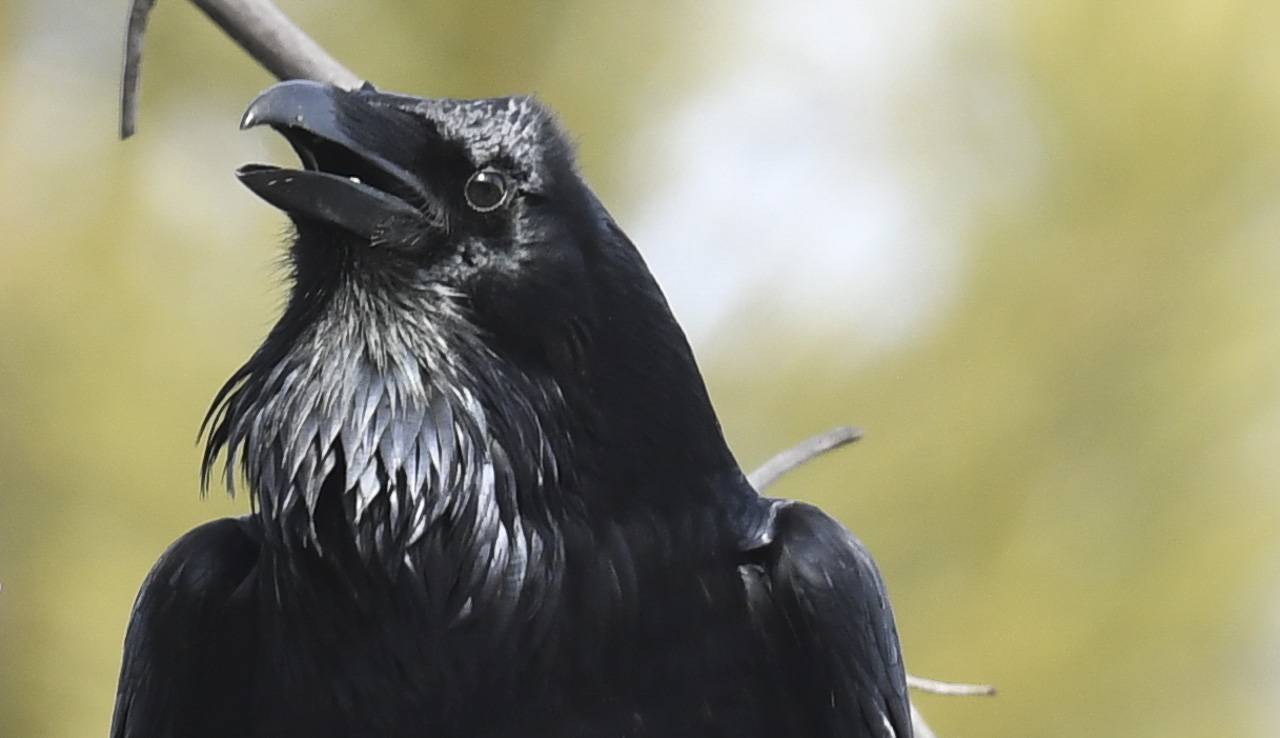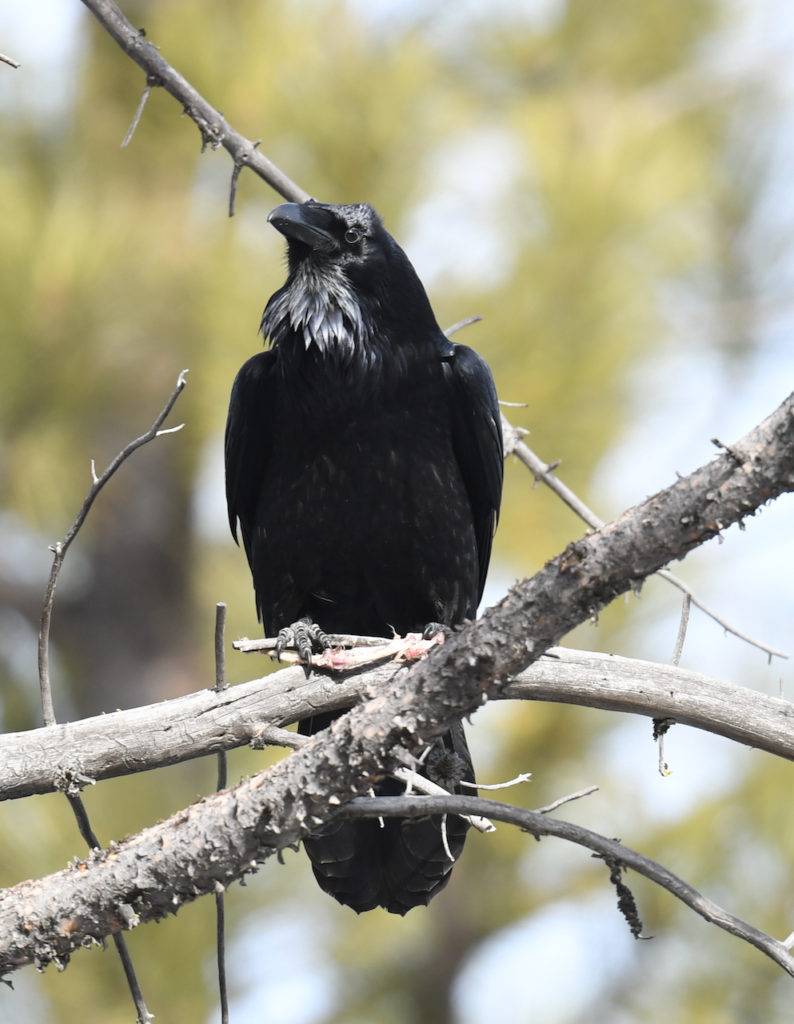(Corvus corax)
By Sevilla Rhoads

Who is that striking dark figure watching you with keen black eyes? The subject of legends across cultures and time, Sunriver is a place the world’s largest and most intelligent songbird calls home. This glossy black bird, appearing to magically absorb sunlight, was revered by the ancient Celts and Nordic peoples, then deeply feared in medieval Europe. Native American tribes almost all feature this mystical creature in their legends as do many other traditions across the globe. Yes, this famous bird is the uncommonly fascinating Common Raven.
If you feel that Raven watching you is plotting something, you are probably right. Some scientists consider the Raven capable of abstract thought and most agree it is one of the most intelligent animals. Previously, researchers thought only Chimpanzees might share with humans the ability to plan and imagine. However, Ravens can plan ahead, solve multi-step problems, and even use and fashion simple tools. From Roman mosaics and Aesop’s fables depicting Ravens (sometimes crows) dropping rocks in containers to raise the water to a drinking level, throughout history humans have admired, and feared the Raven’s thinking skills.

Identification Tips
The Common Raven is a large dark bird, appearing to be all black, with a thick bill and often fluffy neck. They stand around two feet high and can have a four-foot wingspan. In flight, unlike the smaller crow, their tails end in a wedge shape. Crows are rarely sighted in Sunriver, so if you think you see a crow rather than a Raven, look very carefully at the size and shape. Ravens have various calls (up to thirty variations) including a croaky caw and toc-toc noises and can imitate sounds. Find them all year round perched and flying at varying heights or hopping on the ground.
For more information about the Raven see:
https://www.allaboutbirds.org/guide/Common_Raven/id
A flock of Ravens can be referred to as a ‘conspiracy’ or “unkindness,” but Ravens are one of the kinder species. They are fiercely loyal to their life mates, they are devoted parents, and are known to care for each other in times of sickness and danger. Researchers have observed Ravens coming to the aid of other members of the flock in distress. Perhaps this behavior is part of why a Raven was chosen to save Elijah by bringing him food in the King James Version of the Bible.
As you prepare for Valentine’s Day, pause to watch the romantic Ravens for inspiration. Ravens have sweet and beautiful courting rituals. For example, they preen each other’s necks while cooing gently and they dance together in the sky. Even when a couple has been together for many years, they are observed lovingly re-courting each other every breeding season. So, if you are walking Sunriver with your Valentine in February, look around and you may well find a Raven couple sharing the mood. The following words by John James Audubon could well be a Valentine’s card inscription:
There, through the clear and rarefied atmosphere, the Raven spreads his glossy wings and tail, and, as he onward sails, rises higher and higher each bold sweep that he makes, as if conscious that the nearer he approaches the sun, the more splendent will become the tints of his plumage. Intent on convincing his mate of the fervour and constancy of his love, he now gently glides beneath her, floats in the buoyant air, or sails by her side. Would that I could describe to you, reader, the many musical inflections by means of which they hold converse during these amatory excursions! These sounds doubtless express their pure conjugal feelings, confirmed and rendered more intense by long years of happiness in each other’s society. In this manner they may recall the pleasing remembrance of their youthful days, recount the events of their life, and express the pleasure they enjoy.
Particularly in medieval Europe, Ravens were negatively associated with death and bad omens. During that period of Plague, battles, and other sad violent events, bodies were not always buried. Ravens are omnivores. They eat a wide range of food, including carrion. So, Ravens likely did gather around the dead and, being so smart, they likely hung out where there were soon-to-be bodies. Unfortunately, instead of thanking Ravens for their free clean-up services, people often killed them in a superstitious bid to ward off evil.
Even Audubon, who shot plenty of birds himself, noted about the Raven, “His usefulness is forgotten, his faults are remembered and multiplied by imagination; and whenever he presents himself he is shot at, because from time immemorial ignorance, prejudice, and destructiveness have operated on the mind of man to his detriment. … Some say they destroy the Raven because he is black; others, because his croaking is unpleasant and ominous!” Audubon then describes how farmers applying scientific observations and reason understood Ravens actually benefitted their farms in many ways, but he concludes: “Yes, good reader, the farmer knows all this well, but he also knows his power, and, interfere as you may, with tale of pity or of truth, the bird is a Raven, and, as LAFONTAINE has aptly and most truly said, “La loi du plus fort est toujours la meilleure!” Blaming Ravens for human-caused problems continues to this day where they are shot, trapped, and poisoned for reasons some scientists dispute as lacking factual support.
With one of the largest ranges for a songbird, the Raven lives in almost every temperate area of the world but are concentrated in the northern hemisphere. Likely due to their intelligence, Ravens adapt to many habitats. For example, they have figured out where humans have created easy food sources such as landfills. Perhaps needing space and suitable nesting sites, unlike crows, Ravens rarely live in cities. Wherever they live, Ravens have interesting relationships with the other animals around them. Preferring to scavenge for food, Ravens figure out where other species create carrion sources. They patrol the roads around Sunriver, so they are usually the first responders to clean up roadkill.
One particularly close inter-species relationship reported and studied throughout history is between ravens and wolves. In some places, people call ravens ‘wolf birds.’ Scientists in places like Yellowstone believe ravens and wolves communicate with each other about food. Ravens have been observed playing stick games with wolf pups, some of whom they can develop a special bond. Wolves were once common in Central Oregon, so perhaps Sunriver once had wolf Raven friendships.
Ravens have clever ways of stealing food from predators. A favorite trick is pulling on the predator’s tail! There is an entire Twitter site devoted to photos and videos of Ravens tugging tails to distract predators, including the tails of otters, a Polar Bear, a big cat, geese and even flying birds of prey. Looking over the Sunriver golf courses and meadows, you well might see a Raven chasing a bird of prey either to grab its catch or shoo it away. Ravens also attack drones.
So much more could be said about the Raven, but a final note for birders in Sunriver is to pay attention to Raven calls and behavior if you are looking for owls and other birds of prey. Ravens (and jays) often protest loudly when a bird of prey is hiding nearby.
To read more of Audubon’s notes on the Raven and other birds see: https://www.audubon.org/birds-of-america
